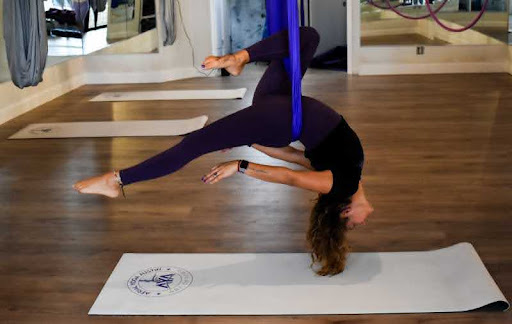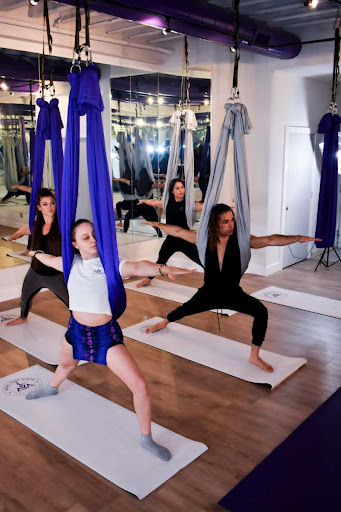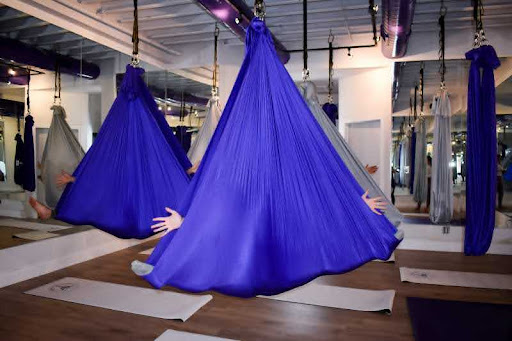13 Best Aerial Yoga Poses You Need To Learn

Aerial yoga has soared in popularity over the last few years, and for good reason. Suspending your body in soft fabrics allows for spine decompression, deeper stretches, and creative poses not possible on a mat. Aerial yoga poses build core strength and flexibility while reducing strain on your joints and stress. Even beginners can safely attempt basic postures with the hammock support.
This blog post will share 13 of the top aerial yoga postures that both novice and experienced yogis should learn. This collection of poses provides an excellent full-body workout, from seated and reclining positions to heart-opening backbends and inversions.
Whether you take aerial yoga in a studio or set up your own hammock at home, practicing these 13 essential aerial postures in your routine will help you improve balance, increase mobility, relieve tension, and experience the unique sensation of flying. With the right set-up and safety precautions, individuals of all fitness levels can unlock the many benefits of aerial yoga practice.
Let’s get off the ground and start flying!
What is Aerial Yoga

Aerial Yoga, a harmonious blend of traditional yoga, pilates, and aerial acrobatics, is an innovative practice that uses a hammock or silk fabric as a tool to help practitioners achieve traditional yoga poses.
The roots of aerial yoga trace back to the late 1990s, when it was first conceptualized and developed by pioneers looking to enhance the traditional yoga experience. This form of yoga was born out of the desire to combine the physical alignment and postural benefits of yoga with the exhilarating, playful elements of the aerial arts.
Over the years, it has evolved into a comprehensive practice that emphasizes mind-body connection, playful exploration, and a unique approach to wellness.
Benefits of Aerial Yoga Practice

Improved Flexibility: Aerial yoga can naturally enhance flexibility over time. The hammock acts as a support system, allowing you to deepen your stretches and poses beyond what might be possible on the yoga mat. The three-dimensional movement in the air releases tension and elongates core muscles, leading to enhanced flexibility and range of motion.
Enhanced Strength: Practicing yoga can significantly help boost strength, particularly in the core, arms, and shoulders. Performing yoga poses in the air requires a different set of muscles to stabilize and balance, which can lead to enhanced overall muscular tone and strength. The dynamic nature of aerial yoga ensures a full-body workout that strengthens both the upper and lower body.
Stress Relief and Mental Clarity: The aerial yoga practice for the love of movement may alleviate stress and promote mental clarity. The gentle swinging motion of the hammock has a soothing, meditative quality that can help calm the mind. Inversions in aerial yoga can also improve blood flow to your brain, which can enhance cognitive function and promote mental clarity. The aerial yoga practice encourages mindfulness and present-moment awareness, which are key elements in reducing stress and anxiety.
Aerial yoga or anti-gravity yoga fuses traditional yoga with aerial acrobatics, leading to an adaptable workout open to yogis of all skill levels. Whether experienced with asanas or completely new to fitness, aerial yoga’s dynamic blend of postures, movement, and meditation has widespread appeal.
The 13 Best Aerial Yoga Poses


Basic Inverted Bow Pose
Start by sitting on the fabric, leaning back, and letting your head drop towards the ground, allowing your body to hang freely. This pose helps to decompress the spine and is also known as an inverted dangle.
Flying Mountain Pose
Stand underneath the hammock and hold it with both hands. Walk your feet back until your body forms a straight line from hands to feet, like the look of an inclined mountain. This pose strengthens the arms and back.
Aerial Lunges
Holding the fabric for support, step your right or left foot forward into a lunge position. The fabric aids in balance and allows for a deeper stretch in the legs and hips.
Floating Butterfly
Sit in the hammock and bring the soles of your feet together, letting your knees drop out to the sides. This pose opens up the hips and resembles the traditional Butterfly pose but in a suspended form.
Star Inversion
From an inverted position, spread your arms and legs wide, forming a star shape with your body. This pose helps in improving circulation and is a more open version of the Basic Inversion.
Suspended Warrior
Holding onto the hammock, lean forward and lift your right or left leg back and up, keeping your body and lifted leg parallel to the ground. This pose challenges balance and strengthens the standing leg, similar to the traditional Warrior III pose.
Aerial Pigeon
Sit in the hammock, place one ankle on the opposite thigh near the knee, and sit back. This pose helps in stretching the glutes and resembles the Pigeon pose on the ground.
Hammock Plank
Face down with the hammock under your stomach, and extend your legs and arms to form a plank position. This pose strengthens the core and arms, similar to a traditional plank but with added support from the hammock.
Zero-Gravity Chair
Sit in the hammock, lean back, and extend your legs upward, forming a relaxed, seated position or in a chair pose. It’s a restful pose that resembles sitting in an imaginary chair in the air.
Aerial Savasana
Lie completely flat inside the hammock, allowing your body to be fully supported and relaxed. This is a floating version of the traditional Savasana or Corpse Pose, ideal for relaxation.
Angel Wings
From an inverted position, extend your arms out to the sides like wings. This pose helps in stretching the chest and shoulders.
Flying Dog
Place your hands on the ground in a downward dog position and let the hammock support your hips. This pose stretches the back and legs, offering a variation of the Downward-Facing Dog.
Aerial Bridge
Lie back with the hammock under your shoulder blades. Press your feet into the ground and lift your hips, forming a bridge. This pose strengthens the glutes and stretches the chest, similar to the traditional Bridge pose.
Getting Ready for Your Aerial Yoga Class

A successful and enjoyable aerial yoga swing depends on selecting the right equipment and setting up a safe space.
Choose the Right Type of Aerial Yoga Hammock
The aerial yoga hammock, also known as a yoga swing or silk, is the cornerstone of any aerial yoga practice. These hammocks come in various materials, such as high-density nylon or silk, each offering a different grip and stretch level.
Some are single-point hammocks, ideal for spinning and more dynamic movements, while others are two-point hammocks, offering more stability in static poses. When selecting a hammock, consider factors like material durability, weight capacity, and personal comfort preferences.
Ensure the hammock is securely anchored to a beam, ceiling, or a sturdy stand. The rigging equipment, including carabiners, swivels, and rigging plates, should be of high quality and rated for more than your body weight. Regularly inspect your equipment for wear and tear and replace it as necessary. Place a yoga mat underneath your hammock for additional safety and comfort.
Setting Up Your Indoor vs Outdoor Setup
Aerial yoga swings can be practiced both indoors and outdoors. Indoor setups require a strong, stable anchor point in the ceiling, whereas outdoor setups often use a portable aerial rig. When practicing indoors, ensure the room has enough space for movement around the hammock. Outdoor setups offer fresh air and a connection with nature, but it’s imperative to consider weather conditions and ensure the setup is on stable, level ground.
Regardless of where you set up, ensure there’s adequate clearance around and above the hammock. A general rule is to have at least a 6-foot radius clear around the hammock and about 3 to 4 feet of space above. This space is essential to perform poses safely and avoid collisions with walls, furniture, or the ground. Also, ensure the area is free of sharp objects and has a soft surface or yoga mat to cushion any falls.
The preparation not only ensures safety but also enhances the overall experience. The preparation allows you to fully immerse yourself in aerial yoga’s unique relaxation and rewarding world.
Aerial Yoga Safety Tips

Aerial yoga requires strength, flexibility, and balancing skills to avoid injury. Here are some tips to practice aerial yoga safely.
Warm-Up and Cool-Down
It’s important to warm up before an aerial yoga class to prepare your muscles and increase your range of motion. Simple stretches, yoga flows, and breathing exercises help prevent injury. Cooling down after class with gentle stretches allows your body to transition out of poses slowly. Rushing into intense poses or abrupt movements can strain muscles.
Listening to Your Body
Pay close attention to any discomfort, fatigue, or pain during aerial yoga. Don’t push yourself too far into any poses. Modify movements to accommodate your current flexibility and strength levels. Overextending joins, or soft tissues can lead to acute or overuse injuries. Know your limitations, and don’t compare yourself to other students.
When to Seek Professional Guidance
Meet with a physiotherapist, sports medicine doctor, or orthopedist if you have a history of injuries, chronic conditions, or pain. Get clearance before starting an aerial yoga practice. A professional can assess your mobility, stability, and fitness to determine safe movements or pose modifications. Don’t take risks that could worsen existing injuries without consulting your doctor.
In Summary
Aerial yoga is an exciting and innovative way to experience traditional yoga’s physical and mental benefits while being suspended in soft fabric hammocks. It allows for greater mobility, flexibility, and strength-building than yoga on a mat.
By starting with some of the foundational postures on this list of 13 essential aerial yoga poses, you can build your aerial repertoire. Just be sure to select high-quality equipment, set up your space properly, and listen to your body to practice safely. With an open mind and caution, anyone can unlock aerial yoga’s freeing sensation of floating in the air. Give your practice a new dimension and achieve wholesome wellness for both body and mind with aerial yoga’s grace and lightness.
Find a Local Yoga Class Near You in Austin
Join a class at Aerial Yoga Austin if you live in the Lakeway and Austin area and want to experience the many benefits of aerial yoga for yourself! Aerial Yoga Austin’s experienced instructors will guide you through creative flows and postures to build strength and flexibility while suspended above the ground. Sign up today and fly through your first aerial yoga class!
Namaste!